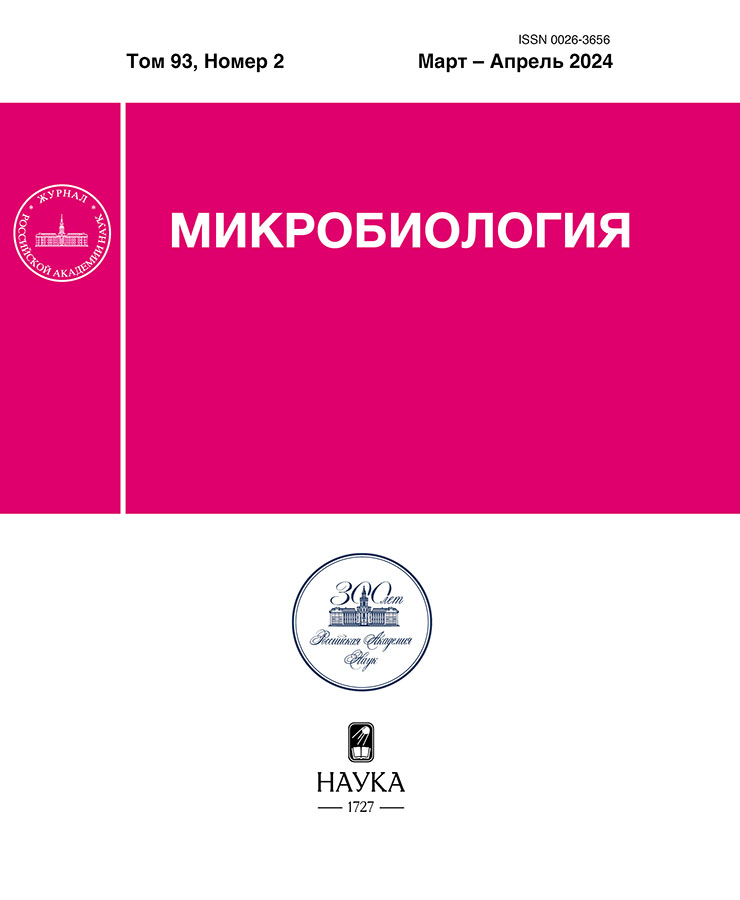Activity of East Siberian Trichoderma Isolates against Plant-pathogenic Microorganisms
- Autores: Kuznetsova V.Е.1, Matveeva E.A.1, Belovezhets L.A.1
-
Afiliações:
- Favorsky Irkutsk Institute of Chemistry, Siberian Branch, Russian Academy of Sciences
- Edição: Volume 93, Nº 2 (2024)
- Páginas: 164-167
- Seção: SHORT COMMUNICATIONS
- URL: https://edgccjournal.org/0026-3656/article/view/655129
- DOI: https://doi.org/10.31857/S0026365624020123
- ID: 655129
Citar
Texto integral
Resumo
The genus Trichoderma comprised important antagonists of pathogenic fungi and can be used in agriculture to combat various plant diseases. In the course of the present work, two micromycete strains were isolated from wood cuts in Eastern Siberia, which were identified by morphological and molecular genetic characteristics as Trichoderma atroviride and Trichoderma harzianum. These Trichoderma strains efficiently inhibited the development of the pathogenic fungi studied (by up to 80%). The data presented in the paper indicate that Trichoderma atroviride and Trichoderma harzianum may be promising for further study of the means of biocontrol of plant diseases.
Palavras-chave
Texto integral
Sobre autores
V. Kuznetsova
Favorsky Irkutsk Institute of Chemistry, Siberian Branch, Russian Academy of Sciences
Autor responsável pela correspondência
Email: uchiha-viksya@mail.ru
Rússia, Irkutsk, 664033
E. Matveeva
Favorsky Irkutsk Institute of Chemistry, Siberian Branch, Russian Academy of Sciences
Email: uchiha-viksya@mail.ru
Rússia, Irkutsk, 664033
L. Belovezhets
Favorsky Irkutsk Institute of Chemistry, Siberian Branch, Russian Academy of Sciences
Email: uchiha-viksya@mail.ru
Rússia, Irkutsk, 664033
Bibliografia
- Всероссийская коллекция микроорганизмов. [Электронный ресурс] URL: http://www.vkm.ru/rus. (дата обращ. 25.04.2023).
- Научный центр “Курчатовский институт”. Научно-исследовательский институт генетики и селекции промышленных микроорганизмов. [Электронный ресурс] URL: https://vkpm.genetika.ru. (дата обращ. 25.04.2023).
- Arasu M.V., Vijayaraghavan P., Al-Dhabi N.A., Choi K.C., Moovendhan M. Biocontrol of Trichoderma gamsii induces soil suppressive and growth-promoting impacts and rot disease-protecting activities // J. Basic Microbiol. 2023. V. 63. Р. 801‒813.
- https://doi.org/10.1002/jobm.202300016
- Guzmán-Guzmán P., Kumar A., de los Santos-Villalobos S., Parra-Cota F.I., Orozco-Mosqueda Md.C., Fadiji A.E., Hyder S., Babalola O.O., Santoyo G. Trichoderma species: our best fungal allies in the biocontrol of plant diseases — a review // Plants. 2023. V. 12. Art. 432.
- https://doi.org/10.3390/plants12030432
- Haghi Z., Mostowfizadeh-Ghalamfarsa R., Steinberg C. The efficacy of Iranian Pythium oligandrum isolates in biocontrol of soil-borne fungal pathogens of tomato // J. Plant Pathol. 2023. V. 105. Р. 185‒196.
- https://doi.org/10.1007/s42161-022-01245-5
- Harman G.E., Doni F., Khadka R.B., Uphoff N. Endophytic strains of Trichoderma increase plants’ photosynthetic capability // J. Appl. Microbiol. 2019. V. 130. Р. 529‒546.
- https://doi.org/10.1111/jam.14368
- Illescas M., Morán-Diez M.E., Martínez de Alba Á.E., Hermosa R., Monte E. Effect of Trichoderma asperellum on wheat plants’ biochemical and molecular responses, and yield under different water stress conditions // Int. J. Mol. Sci. 2022. V. 23. Art. 6782.
- https://doi.org/10.3390/ijms23126782
- Jiang F., Peng Ye., Sun Q. Pesticides exposure induced obesity and its associated diseases: recent progress and challenges // J. Future Foods. 2022. V. 2. Р. 119‒124.
- https://doi.org/10.1016/j.jfutfo.2022.03.005
- Kekalo A.Yu., Zargaryan N.Yu., Nemchenko V.V. Effectiveness of fungicidal protection of spring wheat against powdery mildew and tan spot // Siberian Herald of Agricultural Science. 2023. V. 53. № 1. Р. 45‒52. https://doi.org/10.26898/0370-8799-2023-1-6
- Kumar J., Kumar M., Tomar A., Vaishali, Kumar P., Chand P. Morphological and molecular characterization of Trichoderma spp. from rhizosphere soil and their antagonistic activity against Fusarium spp. // Int. J. Plant Soil Sci. 2021. V. 33. Р. 100‒112.
- https://doi.org/10.9734/ijpss/2021/v33i1930605
- Lyubenova A., Rusanova М., Nikolova M., Slavov S.B. Plant extracts and Trichoderma spp.: possibilities for implementation in agriculture as biopesticides // Biotechnology and Biotechnological Equipment. 2023. V. 37. Р. 159‒166.
- https://doi.org/10.1080/13102818.2023.2166869
- Manzar N., Kashyap A.S., Goutam R.S., Rajawat M.V.S., Sharma P.K., Sharma S.K., Singh H.V. Trichoderma: Advent of versatile biocontrol agent, its secrets and insights into mechanism of biocontrol potential // Sustainability. 2022. V. 14. Art. 12786.
- Pani S., Kumar A., Sharma A. Trichoderma harzianum: an overview // Bull. Environ. Pharmacol. Life Sci. 2021. V. 10. № 6. Р. 32‒39.
- Putranto W.A., Nugroho R.A., Hardiyanta S.P., Cahyaningrum D.Ch. Are Trichoderma atroviride and Trichoderma harzianum effective to control Fusarium associated with tomato wilt? // Microbiology Indonesia. 2021. V. 15. № 3. Р. 84‒90.
- https://doi.org/10.5454/mi.15.3.2
- Rola K., Majewska E., Chowaniec K. Interaction effect of fungicide and chitosan on non-target lichenized fungi // Chemosphere. 2023. V. 316. Р. 137772.
- https://doi.org/10.1016/j.chemosphere.2023.137772
Arquivos suplementares













